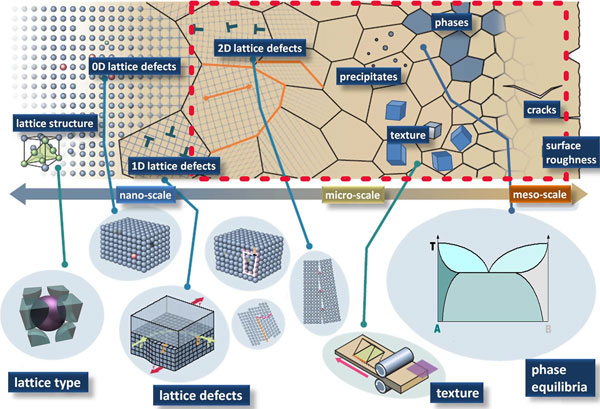Crossref Citations
This article has been cited by the following publications. This list is generated based on data provided by
Crossref.
Darvishi Kamachali, Reza
Schwarze, Christian
Lin, Mingxuan
Diehl, Martin
Shanthraj, Pratheek
Prahl, Ulrich
Steinbach, Ingo
and
Raabe, Dierk
2018.
Numerical Benchmark of Phase-Field Simulations with Elastic Strains: Precipitation in the Presence of Chemo-Mechanical Coupling.
Computational Materials Science,
Vol. 155,
Issue. ,
p.
541.
Koschmieder, L.
Hojda, S.
Apel, M.
Altenfeld, R.
Bami, Y.
Haase, C.
Lin, M.
Vuppala, A.
Hirt, G.
and
Schmitz, G.J.
2019.
AixViPMaP®—an Operational Platform for Microstructure Modeling Workflows.
Integrating Materials and Manufacturing Innovation,
Vol. 8,
Issue. 2,
p.
122.
Brostow, Witold
and
Osmanson, Allison T.
2019.
From mechanics to thermodynamics: A relation between the brittleness and the thermal expansivity for polymers.
Materials Letters: X,
Vol. 1,
Issue. ,
p.
100005.
Roters, F.
Diehl, M.
Shanthraj, P.
Eisenlohr, P.
Reuber, C.
Wong, S.L.
Maiti, T.
Ebrahimi, A.
Hochrainer, T.
Fabritius, H.-O.
Nikolov, S.
Friák, M.
Fujita, N.
Grilli, N.
Janssens, K.G.F.
Jia, N.
Kok, P.J.J.
Ma, D.
Meier, F.
Werner, E.
Stricker, M.
Weygand, D.
and
Raabe, D.
2019.
DAMASK – The Düsseldorf Advanced Material Simulation Kit for modeling multi-physics crystal plasticity, thermal, and damage phenomena from the single crystal up to the component scale.
Computational Materials Science,
Vol. 158,
Issue. ,
p.
420.
Zhang, Mengqi
Tang, Bin
Yang, Ruimeng
Wang, William Yi
Kou, Hongchao
and
Li, Jinshan
2020.
Combined crystal plasticity simulations and experiments for parameter identification: application to near-β titanium alloy.
Journal of Materials Science,
Vol. 55,
Issue. 30,
p.
15043.
Shveykin, Alexey
Trusov, Peter
and
Sharifullina, Elvira
2020.
Statistical Crystal Plasticity Model Advanced for Grain Boundary Sliding Description.
Crystals,
Vol. 10,
Issue. 9,
p.
822.
Diehl, Martin
Wang, Ding
Liu, Chuanlai
Rezaei Mianroodi, Jaber
Han, Fengbo
Ma, Duancheng
Kok, Piet J. J.
Roters, Franz
and
Shanthraj, Pratheek
2020.
Solving Material Mechanics and Multiphysics Problems of Metals with Complex Microstructures Using DAMASK—The Düsseldorf Advanced Material Simulation Kit.
Advanced Engineering Materials,
Vol. 22,
Issue. 3,
Romanov, Kirill A.
and
Shveykin, Alexey I.
2021.
Statistical crystal plasticity model of commercially pure titanium: Validation and estimation of sensitivity to impacts perturbations.
Vol. 2371,
Issue. ,
p.
040007.
Shveykin, A.I.
Trusov, P.V.
and
Romanov, K.A.
2021.
An approach to numerical estimating the stability of multilevel constitutive models.
Computational Continuum Mechanics,
Vol. 14,
Issue. 1,
p.
61.
Zhang, Yabo
Bai, Qingshun
Bai, Jinxuan
Guo, Hui
and
Cheng, Kai
2021.
Dislocation evolution in nanoscratching the CVD diamond film: Discrete dislocation dynamics simulation and experiments.
MRS Communications,
Vol. 11,
Issue. 5,
p.
619.
Trusov, Peter
Shveykin, Alexey
and
Kondratev, Nikita
2021.
Some Issues on Crystal Plasticity Models Formulation: Motion Decomposition and Constitutive Law Variants.
Crystals,
Vol. 11,
Issue. 11,
p.
1392.
Opara, Jarosław
Straumal, Boris
and
Zięba, Paweł
2021.
Cellular Automata Modelling of Discontinuous Precipitation.
Materials,
Vol. 14,
Issue. 17,
p.
4985.
Shveykin, A.I.
Trusov, P.V.
and
Romanov, K.A.
2021.
Some results of a numerical estimating of the stability of the FCC metal two-level constitutive model.
Computational Continuum Mechanics,
Vol. 14,
Issue. 2,
p.
127.
Shveykin, Alexey
Romanov, Kirill
and
Trusov, Peter
2022.
Some Issues with Statistical Crystal Plasticity Models: Description of the Effects Triggered in FCC Crystals by Loading with Strain-Path Changes.
Materials,
Vol. 15,
Issue. 19,
p.
6586.
Mianroodi, Jaber Rezaei
Shanthraj, Pratheek
Liu, Chuanlai
Vakili, Samad
Roongta, Sharan
Siboni, Nima Hamidi
Perchikov, Nathan
Bai, Yang
Svendsen, Bob
Roters, Franz
Raabe, Dierk
and
Diehl, Martin
2022.
Modeling and simulation of microstructure in metallic systems based on multi-physics approaches.
npj Computational Materials,
Vol. 8,
Issue. 1,
Romanov, Kirill
Shveykin, Alexey
and
Trusov, Peter
2023.
Advanced Statistical Crystal Plasticity Model: Description of Copper Grain Structure Refinement during Equal Channel Angular Pressing.
Metals,
Vol. 13,
Issue. 5,
p.
953.
Zhang, Can
and
Shi, Mingxing
2024.
Indentation-induced plastic behavior of nanotwinned CuNi alloy: an atomic simulation.
Modelling and Simulation in Materials Science and Engineering,
Vol. 32,
Issue. 4,
p.
045013.
Shveykin, Alexey
Trusov, Peter
and
Romanov, Kirill
2024.
Stability of Crystal Plasticity Constitutive Models: Observations in Numerical Studies and Analytical Justification.
Metals,
Vol. 14,
Issue. 8,
p.
947.
Nascimento, Anderson
Pedgaonkar, Akhilesh
Bronkhorst, Curt A.
and
Beyerlein, Irene J.
2024.
Microplasticity in polycrystalline materials from thermal cycling.
Computational Mechanics,
Diehl, Martin
2024.
Comprehensive Mechanics of Materials.
p.
235.




